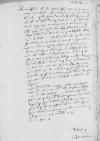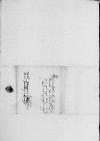Hac nocte sunt mihi allatae ⌊⌋, quibus hortatur, ut adiunctu written over a⌈auu written over a⌉s fasciculus quam primum ad ⌊illustrissimum dominum castellanum Cracoviensem⌋ transmittatur. Quem hodie abhinc ⌊Viennam⌋ versus misi et ordinavi, ut quam primum transmittatur[1]. Misi quoque iam pridem alios duos fasciculos ⌊Cracoviam⌋ iuxta desiderium Vestrae Reverendissimae Dominationis. Et quod usque hodie ad ⌊⌋ non responderim, in causa est, quod praecise eo tempore vocatus eram ex abrupto in curiam ⌊serenissimi regis mei⌋ venire. Veni et celerrime expeditus ad ⌊serenissimum regem Poloniae⌋ iter arripui[2]. Denuo revocatus et ad hanc provinciam[3] delegatus[4] heri huc[5] cum domino ⌊Wilhelmo de Rogndarff⌋[6] etc. et domino ⌊Leonardo de Fels⌋ etc. veni pro firmandis indutiis annalibus[7]. Duxeram litteras Vestrae ills Reverendissimae Dominationis nomine versus ⌊Cracoviam⌋. Abinde sperabam me bono otio posse Vestrae Reverendissimae Dominationi respondere. Supplico igitur Eidem Vestrae Reverendissimae Dominationi me in ea re excusatum habere et Sibi persuadere, quicquid in mittendis eiusmodi litteris et aliis quibuscumque potero Illi inservire, id percupide me facturum et cum diligentia.
Misi etiam litteras illas annexas ad ⌊reverendissimum dominum archiepiscopum Rosanensem⌋[8] ad manus domini ⌊Wolfen Grastwein⌋, sororii mei, ut illas praesentet. Apud nos nihil novi habetur, nisi quod quidam ⌊Hungari⌋ practicant, ut neutrum litigantium pro regno suscipiant, sed quendam tertium cuperent[9]. Gens inquieta,
cf. Vulg. Ps (G) 34.4 qui cogitant malum mihi; Vulg. Ps (G) 70.24 qui quaerunt mala mihi; Vulg. Ps (G) 70.13 ⌊quae semper suum quaerit malumcf. Vulg. Ps (G) 34.4 qui cogitant malum mihi; Vulg. Ps (G) 70.24 qui quaerunt mala mihi; Vulg. Ps (G) 70.13 ⌋
. His Vestrae Reverendissimae Dominationi me et servitia mea denuo commendo.


 UUB, H. 154, f. 50v
UUB, H. 154, f. 50v